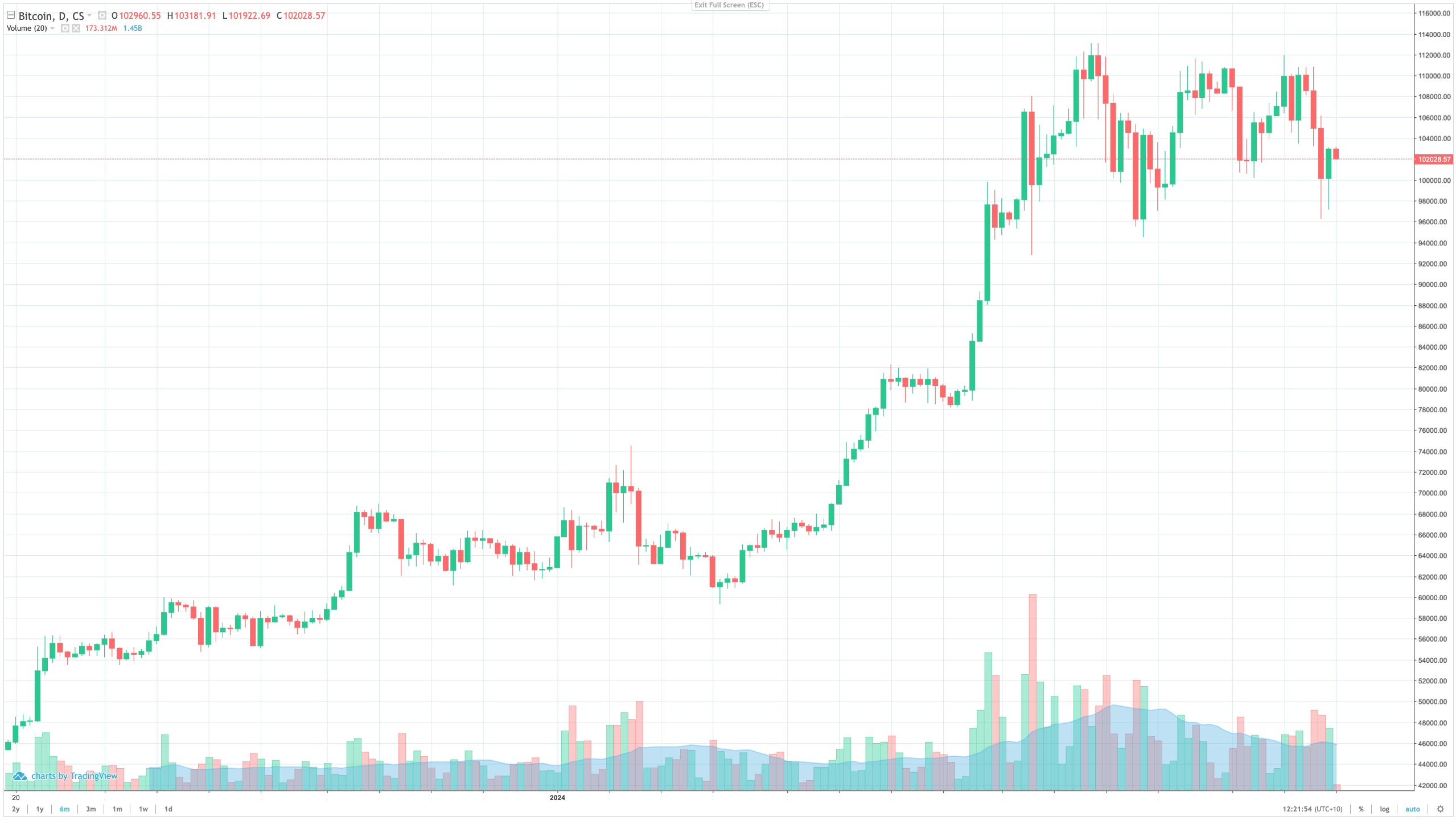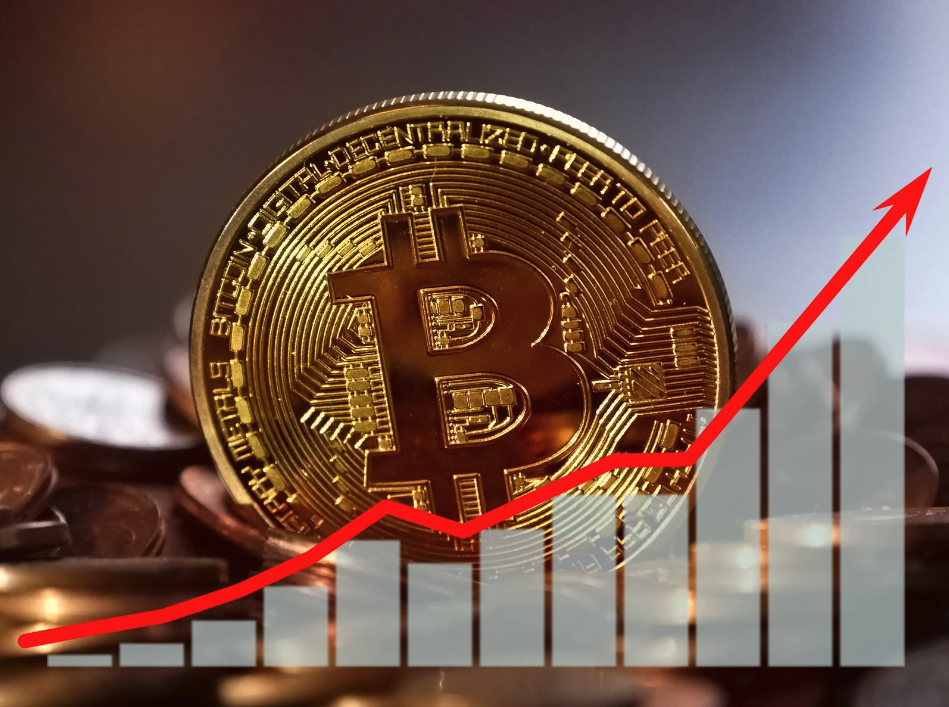Dozens of cryptocurrencies are traded daily in 2024. And yet, none has achieved anywhere near the value, scale and recognisability that Bitcoin has. As Bitcoin moves, so does much of the market. It’s the first ever crypto and continues to maintain that first mover advantage. Any major Bitcoin development draws global attention, and few Bitcoin events reverberate across the cryptocurrency market as much as the halving.
Bitcoin’s price touched a new all-time high of US$73,835 (AUD 113,800) on March 14, 2024. Its value has increased about 150% in the last 6 months and the upcoming halving could be one of the main reasons. In this article we take a look at Bitcoin’s halving, breaking it down so that both seasoned investors and newbies can relate to it.

Understanding Bitcoin Mining
Understanding what the Bitcoin halving means begins with a foundational knowledge of Bitcoin mining. Blockchain technology works by creating blocks (or records) of information that are added to the chain – hence the name. This decentralised proof-of-work mechanism for creating, verifying and adding data to the global ledger is known as mining.
Miners use powerful computers to solve complex mathematical problems, verify transactions and add new records to the blockchain. For their effort, they are currently rewarded with 6.25 Bitcoins. It is the equivalent of US$420,000 as of April 2024 – a lucrative incentive for miners to keep adding new blocks. New blocks are added to the blockchain approximately every 10 minutes.

From inception, Bitcoin’s maximum supply was capped at 21 million tokens. At present, approximately 19.6 million tokens have been mined. Thousands of Bitcoins are currently purchased every day, a figure that’s much higher than the 900 tokens mined per day. The number of BTC mined per day will drop to 450 when the Bitcoin halving event occurs.
So, what exactly is the Bitcoin halving?
The Concept of Bitcoin Halving
Bitcoin halving refers to a periodic change in the cryptocurrency’s blockchain protocol that is designed to cut in half the rate at which new Bitcoins are rewarded to miners. It is set to occur each time 210,000 blocks are added to the blockchain.
When Bitcoin was created in January 2009, the mining reward (also called subsidy) was 50 Bitcoins per block. Halving has dropped the reward to 25 Bitcoins in 2012, 12.5 Bitcoins in 2016 and 6.25 Bitcoins in 2020. The April 2024 halving will drop the reward to 3.125 Bitcoins.
Bitcoin's founder(s), under the famously mysterious pseudonym Satoshi Nakamoto, hard coded the halving into the algorithm by reducing the rate Bitcoin mining occurs and therefore the number of new Bitcoins released into circulation. Intended to be a replacement to fiat currencies but devoid of centralised control or government regulation, this action showed important foresight in curtailing inflation in the Bitcoin market.
All other factors constant, reducing a commodity’s supply results in an increase in the commodity’s price. Ensuring the scarcity of Bitcoin effectively guaranteed the long term sustainability of its role as a store of value akin to gold. Bitcoin’s inflation rate is currently under 2% and will fall to less than 1% after the April 2024 halving.
Historical Halvings
Bitcoin halving occurs every four or so years. A look at previous halving events could provide useful pointers on what is likely to occur with future ones.
- November 28, 2012 – The first Bitcoin halving saw the mining reward halved from 50 to 25. It occurred fairly early in Bitcoin’s evolution and only had a minimal impact on the price in the immediate aftermath. Bitcoin’s price at the time was $12. However, the highest price in the subsequent four-year cycle was 93 times higher than it was on halving day.
- July 9, 2016 – The reward halved from 25 to 12.5. Bitcoin’s price at this second halving was $658 and rose just 1.3% in the subsequent days. However, it plunged just a few weeks later. Nevertheless, the highest price in the four-year cycle was 30 times higher than the halving day price.
- May 11, 2020 – Mining reward halved from 12.5 to 6.25. At the time of the third halving, Bitcoin’s price was $8,601 and rose about 12% in the week after the event. It experienced a sharp rally later in the year but this was probably more to do with other market factors such as COVID-related stay-at-home policies resulting in increased savings that retail investors could direct to speculative cryptocurrency accumulation. Still, the price within the cycle peaked at 8 times higher than the price on halving day.
There is debate over whether price changes can fully or mainly be directly attributed to the halving. Past halvings have been accompanied by a significant rise in Bitcoin’s price through the subsequent four-year cycle. The difference between the price on halving day and when the price peaks during the cycle does however seem to be slowing with each new post-halving cycle. This isn’t surprising – as a novel idea, the early years were always going to be marked by explosive growth.

The last Bitcoin halving will happen in 2140 when there will be 21 million Bitcoins in circulation and no further coins will be created. From that point, miners will receive transaction fees paid by anyone transacting on the Bitcoin blockchain.
Implications of Halving
Halving effectively slows Bitcoin production, making mining less profitable. However, there are varying views on the price implication of halving.
On the one extreme, there is the belief that basic principles of demand and supply will inevitably lead to a sustained price increase before and well after the event. In part, this could be due to speculators trading on the event hoping for a quick windfall. However, Bitcoin accumulation by longer term investors is likely to be a greater contributor to the price lift over time. In fact, some argue that the rise in Bitcoin’s price in recent months is in anticipation of the April halving.
The more pessimistic perspective holds that halving reduces rewards for miners which would translate to lower block production and therefore a stagnation in the price. Some speculate that as rewards diminish, miners may move processing power out of Bitcoin mining and seek to make up the earnings shortfall by pursuing transaction fees elsewhere within or beyond the Bitcoin network.
Either way, the predictable nature of the halving (the market knows it will occur, when it will occur and what the new reward will be) is designed to reduce shock to the Bitcoin network. That way, investors can plan their strategies and take trading positions well in advance.
Preparing for the Halving in April 2024
As halving is triggered when a certain number of tokens is reached due to Bitcoin miners’ activity, there can be no certainty on the specific date when it is bound to occur. However, most experts project that it will happen in the latter part of April 2024 – possibly around the 19th. That’s the date the blockchain should reach block 840,000. Thereafter, the mining reward will drop from 6.25 to 3.125 Bitcoins.
Consistent with past halving events, there is already significant price volatility in the weeks leading up to the halving. The more sustainable price rise however often occurs several months later.
In anticipation of the April 2024 halving, trading volume has risen sharply on centralised exchanges as traders and investors take positions in anticipation of the halving event. This has been further accelerated by fresh ETF demand in large part due to the US SEC’s approval of Bitcoin spot ETFs in January. The first month of BTC ETFs averaged net inflows of approximately US$125 million daily.
Still, past halving trends show the impact of halving on Bitcoin prices is shrinking. That is perhaps because there is a much larger supply of Bitcoin available for sale today (19.6 million) than what remains to be mined (about 1.35 million). The new supply’s impact is diluted with each halving.
Further, the industry has significantly matured with multiple cryptocurrencies now competing with Bitcoin for users. There is no guarantee demand will rise and, even if it does, it’s unlikely to be to the same degree as past halvings. So even where there has been some change in price, past halving events show that it is usually just one of many other market factors responsible.
The best strategy would appear to be a longer term one that capitalises on the growth of the network overall as a globally-accepted store of value. So whereas the next halving is imminent, savvy miners and investors already have their eyes on the next one that happens in 2028.
Conclusion
The Bitcoin halving is a critical ingredient in the cryptocurrency’s stability and longevity. Devoid of the regulation and control that’s characteristic of fiat currencies, Bitcoin’s algorithm design stays true to its founders dream of a self-sustaining digital currency. Whether the halving is accompanied by a price rise or not, it underscores Bitcoin’s power as a store of value and its growing role in mainstream finance.


